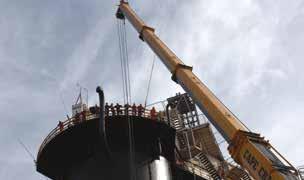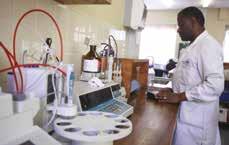
9 minute read
Oil, gas and petrochemicals
Offshore gas discoveries could boost South Africa’s economy.
The Virginia Gas Project is ramping up. Credit: Renergen
South Africa has set a target of 3 000MW of gas power in the national grid by 2030. This is laid out in the country’s most recent Integrated Resources Plan (IRP), which guides national targets in each of the various methods of power generation and which is tilted towards renewable energy.
Although there have been encouraging finds off the southern coast of South Africa and prospects for shale gas appear to be good in the country’s interior, it has been pointed out by the commercial growth director of GE Gas Power for Sub-Saharan Africa, Michael Konadu, that these prospects are yet to be commercialised. When this fact is added to the logistical difficulties and security concerns surrounding the gas resource available from Mozambique, Konadu argues that liquified natural gas (LNG) should be the vehicle for meeting the objectives of the IRP and the national Gas Master Plan. His preferred method would be for a consortium to assume project risk, including terminal and plant infrastructure. The state could take a stake through Transnet or the Central Energy Fund.
Whether it is via new imports of LNG or the development of the Brulpadda and Luiperd prospects off the southern coast, there is no doubt that new feedstock is needed for the PetroSA GTL refinery at Mossel Bay. Commissioned in 1992 as the world’s first gas-to-liquids (GTL) refinery, it plays an important role in the regional and national economy but it has effectively run out of feedstock. The entity is considering extracting geothermal energy from nine of its wells that are now depleted of gas as a way of fending off decommissioning.
Total E&P South Africa BV, the operator and majority stakeholder in the joint venture which is drilling, has not yet taken a decision about what further steps it might take now that the first drilling operations have been shown to be successful. The drilling was successful enough to warrant the return of the semi-submersible rig Deepsea Stavanger from Norway to South Africa and in August 2020 the rig made more discoveries at the nearby Luiperd prospect. The JV partners are Qatar Petroleum International Upstream LLC, CNR International and Main Street 1549 Proprietary Ltd.
Petroleum Agency South Africa (PASA), which encourages exploration and regulates the oil and gas industry, has noted the significance of international oil companies committing to exploration off South Africa’s coast.
Another drilling project was launched in September 2020 in the Karoo. The Council for Geoscience (CGS) announced phase two of the Karoo Deep Drilling and Geoenvironmental Baseline Project
SECTOR INSIGHT A helium project in the Free State is set to join an elite club.
Offshore gas finds could revitalise the gas-to-oil facility at Mossel Bay. Credit: PASA

(KDD) in Beaufort West. The geoscientific research project in the Karoo Basin is aimed at developing a geo-environmental baseline model with a focus on assessing the potential environmental impacts of shale gas development.
A Gas Utilisation Master Plan (GUMP) is being developed as a part of national energy policy. Private companies are responding to this changed environment.
Tetra4, a subsidiary of Renergen, owns rights to a field of liquified natural gas (LNG) in the Free State and has started ramping up to the next (production) phase of the Virginia Gas Project. The pilot compressed natural gas (CNG) plant was constructed in 2016.
The helium concentration tested by Renergen is at an excellent level and in line with early indicators. So good were the helium flow results announced in early November 2021 that the company’s share price shot up by 14.3% on a single day. The aim in phase one is to produce 350kg/d of helium via cryogenic liquification and to construct a commercial LNG plant. When the project comes on stream, it will become one of just 16 such facilities in eight countries globally. Production of helium is expected to grow to five tons in the second phase.
The SpaceX rocket that launched in 2021 used 11 tons of helium to propel itself off the ground. Every computer microchip in the world is produced in the presence of helium and the world uses 85 tons of it every day. Although it’s a very useful element, it’s also a very difficult element. Renergen has had to import much of its equipment and many skilled personnel.
First to respond to the potential of this gas find was the logistics sector. Bulk Hauliers International Transport (BHIT) and South African Breweries signed agreements to take LNG to fuel some of its trucks, which should lead to lower operating and maintenance costs.
Renergen has signed an agreement with TotalEnergies for distribution and sale and the potential of another market was revealed in 2021 when Renergen agreed to sell LNG to glass manufacturer Consol. Bespoke depots will be developed.
International chemicals and energy company Sasol has several large plants in Mpumalanga and the Free State. Sasol Gas is one of the four Sasol operations at Secunda, supplying natural gas to Sasol Synfuels and buying Sasol Synfuels’ methanerich pipeline gas. Air Liquide Large Industries SA, a subsidiary of French company Air Liquide, has purchased Sasol’s oxygen production site in Secunda for R8.5-billion. Sasol is selling a number of its assets in an effort to reduce debt.
Most of the oil that feeds the country’s four crude-oil refineries is imported. The refineries are in Cape Town, Sasolburg and Durban (two). In addition to South Africa’s crude-oil refineries, natural-gas conversion plant, coal-to-fuel and gas-to-liquid crude-oil refineries, Sasol produces fuel from coal at its Secunda facility. ■
ONLINE RESOURCES
National Energy Regulator of South Africa: www.nersa.org.za South African National Energy Association: www.sanea.org.za South African Petroleum Industry Association: www.sapia.co.za
Gas will help South Africa achieve net zero
Gas can drive an economic recovery at the same time as building a bridge to a clean energy future, writes Petroleum Agency South Africa CEO, Dr Phindile Masangane.
The biggest threat to humanity is climate change and the biggest threat to South Africa’s social stability is the high unemployment rate, which has primarily been caused by economic stagnation.
As the global economy recovers from the devastating effects of Covid-19, demand for oil and gas has gone up significantly. If there was ever a need for proof that oil and gas still drive the global economy, recent statistics demonstrate the trend.
The world’s developed economies industrialised on the back of oil and gas production and use. Now, just as Africa is on the cusp of being a significant gas producer and is making plans to use such gas for power generation, industrialisation and economic growth, the negative effect of greenhouse gas emissions on the environment has become undeniable.
The urgency for action to mitigate the risk of climate change is no longer debatable. As a responsible global citizen South Africa must take steps to reduce its carbon footprint.
The UN Framework Convention on Climate Change was established in 1992 to coordinate the global response to mitigate the threat of climate change, and specifically to get countries to commit to policies and plans that will ensure that the average global temperature rise is kept less than 1.5°C above pre-industrial levels.
The International Energy Agency (IEA) proposes that to achieve this goal the world’s energy sector must reach net zero emissions by 2050.
Country-specific pathways The IEA “Net Zero by 2050” report acknowledges that there will be a differentiated approach to a clean energy future, taking into consideration the cost of the new clean energy technologies and the economic consequences of transitioning for each country.
The IEA emphasises that each country must develop its own pathway to a net zero emission future.
South Africa’s economy has been predominantly powered by coal, which is also a significant contributor to the country’s economy in terms of GDP as well as employment. Of all primary energy resources coal is the most carbon-intensive, and South Africa therefore has a relatively high carbon-intensive economy, contributing about 1% of annual global greenhouse gas emissions. In addition to coal, South Africa imports oil, gas and petroleum products for its energy needs as the upstream petroleum industry is still at a nascent stage. The two recent world-class gas discoveries in the Outeniqua

basin off the south coast of the country are the biggest petroleum discoveries made in South Africa.
The development of these discoveries has the potential to replace more than 2 300MW of diesel-fired electricity generation in Gourikwa, Dedisa and Ankerlig, thereby reducing the carbon emissions from these plants by more than 50% while eliminating sulphur oxide and nitrogen oxide emissions, which are also harmful to the environment. Gas is therefore an obvious bridge to a lower carbon future in South Africa.
Importantly, these gas discoveries could restore the gas-to-liquid refinery in Mossel Bay to full production and profitability, saving about 1 200 direct jobs. A complete shutdown and abandonment of this refinery would not only lead to job losses at the refinery, but the effects would reverberate throughout the town of Mossel Bay and the Southern Cape region, since the refinery contributes about R2-billion a year, or 26% of the Mossel Bay economy, and 6% to the Southern Cape economy when producing at full capacity.
The Petroleum Agency South Africa awaits the licensee of these gas discoveries submitting its production right and environmental authorisation applications when the exploration right expires, or earlier. The agency expects the licensee to use world-class technologies and standards to minimise the effects of the gas and gas condensate production on the environment, while maximising the in-country benefit or local content from this development to support South Africa’s economic recovery.
These discoveries could indeed support both the country’s economic recovery and its transition to a clean energy future. ■ Credit: Anton Swanepoel


Exciting discovery off Southern Cape coast
In 2019 Total and its partners created a stir with the announcement that gas condensate had been found at a site called Brulpadda off the coast of Mossel Bay.
In 2020, the nearby Luiperd prospect in Block 11B/12B delivered more exciting news. The block, in the Outeniqua Basin 175km off the southern coast, covers an area of about 19 000km² in water depths of 200m to 1 800m. The exploration was done by the semi-submersible rig Deepsea Stavanger (pictured), which journeyed twice from Norway to lead the exploration projects.
The Luiperd prospect is the second of five prospects in the group. Light oil and gas condensate were discovered in significant quantities. The exploration drilling is in deep waters similar to where the gigantic Mozambique Rovuma Basin gas discoveries were made in 2011 and 2012.
These discoveries have exciting repercussions for the development and growth of South Africa’s oil and gas sector. If the local gas market is to take off and thrive, significant drilling has to take place.
PASA, which encourages exploration and regulates the oil and gas industry, has noted the significance of international oil companies committing to exploration off South Africa’s coast. Increased confidence by such companies can only lead to growth in the industry and with the gas finds off Mozambique there are sure to be more companies interested in South Africa’s potential.
In addition to adjudicating on coastal fields, the agency has awarded coalbed-methane-gas exploration rights in KwaZulu-Natal and natural gas exploration permits in the Free State.








